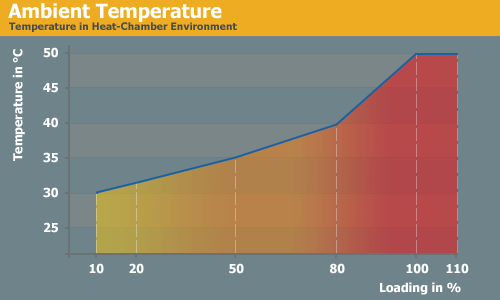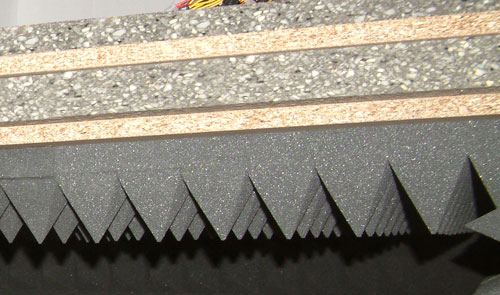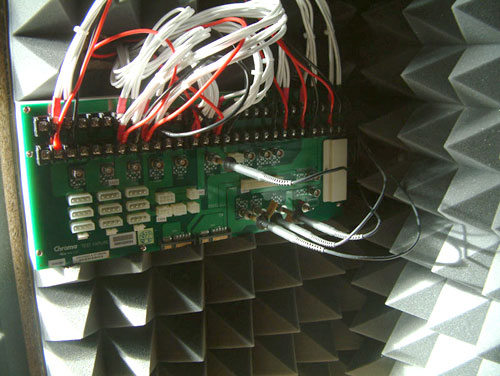Silverstone ST45NF Nightjar
by Christoph Katzer on August 25, 2008 1:00 AM EST- Posted in
- Cases/Cooling/PSUs
Testing with the Chroma ATE Programmable Load

Our test equipment consists of two Chroma programmable DC Loads that enable us to test power supplies with an output of up to 1500W. The biggest advantage of the Chroma DC Loads is simply the high precision it provides. It can measure differences as small as 0.001V and 0.0001A, which will provide us with best-in-class results.
When programming the Chroma with specific amounts of load calculated according to the ATX norm, we are able to load power supplies to an exact percentage. We can now show results at every specific percentage needed. To get the best overview of a power supply, we load each unit with 10%, 20%, 50%, 80%, 100%, and 110% of the specified output. This is easy to calculate for a 1000W power supply: the 10% load is 100W and 110% load is 1100W. Remember that this is the amount of power the PSU delivers; due to inefficiencies, a power supply will actually draw more power from the wall.
Note: If you would like to know more about our testing methodology, equipment, and environment, please read our PSU testing overview.
We have added an additional 10% on the highest load to see how the units perform with overload. This test will be performed in all future reviews. The overload test is performed at room temperature as well as under more stressful conditions; to ensure we are not too cruel to the power supplies, we will keep the ambient temperature at 50°C in the stress test. Experience shows that many units can stand the overload at room temperature but will experience problems with higher temperature and overload together. Only the best-built units will survive this.

The Testing Environment
There is one flaw in testing power supplies with programmable loads while trying to measure the sound pressure levels at the same time. Because the programmable loads get very loud, there is no chance of hearing the power supply on the test stand. In order to make accurate measurements of the noise levels we needed a way to separate the test unit and the programmable loads. Our solution was to build a very thick box around the unit.

We concluded that a five-layer box with a total thickness of 6" (15cm) containing two layers of wood and three layers of special foam would suffice. It is designed as a box within a box. The inner box does not touch any part of the outer box, making it difficult for acoustic noise to pass through in the form of vibration. Each box is isolated on both sides with a layer of heavy foam that is normally used to insulate engines. On the inside we have an additional layer of 4" (10cm) thick pyramidal foam on every side of the box to eliminate the acoustic waves coming from the test object as well as we can.

To ensure a completely closed system we installed the printed circuit board that the connectors of the power supply are attached to inside the anechoic room/box. In other box designs, you would need to put all the cables through the wall. Unfortunately, that would result in the inside of the box not being fully isolated anymore. Our design keeps everything that needs to be connected inside of the box and maintains isolation.










20 Comments
View All Comments
TravisChen - Saturday, August 30, 2008 - link
Can you show us how to get test the output ripple & noise the right way (with the caps mentioned in spec)? I think it's an important part in PSU reviews.Christoph Katzer - Monday, August 25, 2008 - link
Actually that was just to take the screenshots... I still have pretty high spikes now and then even with the caps according to specs.tayhimself - Monday, August 25, 2008 - link
How does this address the point raised? And why are you taking pointless screenshots then?LTG - Monday, August 25, 2008 - link
Yes Tayhimself is right, Christoph you kind of avoided or skimped on a proper response to the questions raised.Authors replying in the comments is a major strength of AT - Please respect that.
So what was wrong, just your screen shots, or some of the testing reported originally as well?
Thank you.
Christoph Katzer - Tuesday, August 26, 2008 - link
I am still working on it to get the spikes sorted. With replying to that post I already meant to say that he was right and that his reply was much more helpful than most others that don't take the time to complete a full sentence... Once I sorted the spike-problem it will be all better.aarvark - Monday, August 25, 2008 - link
Really "of limited use"? A core duo with mid-range graphic card barely tops 150W these days. A basic setup, maybe with integrated graphics would be around 120W. 400W is more than plenty for 99%+ of the market. Remember, us geeks are the exception, not the rule.I'd say the one thing it wasn't suitable for were HTPCs whereby you'd be better off with a picopsu or the like as they are more efficient at very low loads and only $50. Better still by having an external brick most of the heat is outside the case.
Saying that I'm not a fan (no pun intended) of these because they are many, cheaper supplies that have a lazy 12 or 14cm thermally controlled fan which are for all real purposes silent anyway with the huge advantage of giving just a little case airflow through the case.
JarredWalton - Monday, August 25, 2008 - link
I think that last point is why we say "limited use". Basically, you need to want 200-300W of power (gotta leave some wiggle room, right?), and you need to want absolute silence, and you also need to be willing to pay $170+ for it. I'd take a 600W PSU with a large fan over this for under $100 as well. Pico PSUs are an option for small systems that don't require a lot of power, but there are many definitions of HTPC. Personally, I prefer larger systems with more storage options.Freddo - Monday, August 25, 2008 - link
Looks like something I would buy for my next computer :-)Clauzii - Monday, August 25, 2008 - link
The same here :)With specs and quality like that, it's almost impossible to go wrong with this. Also, the cablelengths COULD make it possible to let it rest outside the PC case itself (for DIYs anyway).
And thank You Anandtech, for testing a sub-500 Watt supply :)
pattycake0147 - Tuesday, August 26, 2008 - link
I agree not everybody wants kilowatt a psu a low wattage one like is an excellent change of pace and exactly what I am looking for.